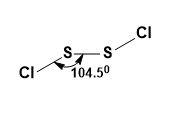
How do you determine bond angle of ${{S}_{2}}C{{l}_{2}}$ ?
Answer
445.2k+ views
Hint: Drawing the dot and cross structure to determine the bonding and non-bonding electrons within the structure. These electrons will help resolve the structure and geometry of a compound which eventually will give the bond angle.
Complete step by step answer:
Let us see the structure and geometry of a compound;
The given compound is Disulphur dichloride i.e. ${{S}_{2}}C{{l}_{2}}$. As we can see, the compound consists of 2 atoms of sulphur and 2 atoms of chlorine. The dot and cross diagram will be as Cl – S – S – Cl; each sulphur atom will have 2 lone pairs of electrons and 2 bonding pairs in accordance to its number of electrons.
- The bond angle in such types of compounds is determined by the VSEPR theory i.e. valence shell electron pair repulsion theory. This theory states that the pairs of electrons in a chemical compound will repel each other and thus they will move far from each other due to the same charge they have.
- This indicates that the structure will bend a little and will cause a difference of nearly 2 to 2.5${}^\circ $ in the bond angle from the tetrahedral geometry. The tetrahedral geometry has the bond angle of $109.5{}^\circ $ but the bond angle differences in the ${{S}_{2}}C{{l}_{2}}$ molecule due to VSEPR theory will be $104.5{}^\circ $ .

Note: Typically, ${{S}_{2}}C{{l}_{2}}$ molecule should have tetrahedral geometry but due to presence of two pairs of electrons in sulphur will result into repulsion and distraction from the tetrahedral geometry. The tetrahedral geometry will add to the bent nature due to repulsion.
Complete step by step answer:
Let us see the structure and geometry of a compound;
The given compound is Disulphur dichloride i.e. ${{S}_{2}}C{{l}_{2}}$. As we can see, the compound consists of 2 atoms of sulphur and 2 atoms of chlorine. The dot and cross diagram will be as Cl – S – S – Cl; each sulphur atom will have 2 lone pairs of electrons and 2 bonding pairs in accordance to its number of electrons.
- The bond angle in such types of compounds is determined by the VSEPR theory i.e. valence shell electron pair repulsion theory. This theory states that the pairs of electrons in a chemical compound will repel each other and thus they will move far from each other due to the same charge they have.
- This indicates that the structure will bend a little and will cause a difference of nearly 2 to 2.5${}^\circ $ in the bond angle from the tetrahedral geometry. The tetrahedral geometry has the bond angle of $109.5{}^\circ $ but the bond angle differences in the ${{S}_{2}}C{{l}_{2}}$ molecule due to VSEPR theory will be $104.5{}^\circ $ .

Note: Typically, ${{S}_{2}}C{{l}_{2}}$ molecule should have tetrahedral geometry but due to presence of two pairs of electrons in sulphur will result into repulsion and distraction from the tetrahedral geometry. The tetrahedral geometry will add to the bent nature due to repulsion.
Recently Updated Pages
Master Class 11 English: Engaging Questions & Answers for Success

Master Class 11 Computer Science: Engaging Questions & Answers for Success

Master Class 11 Maths: Engaging Questions & Answers for Success

Master Class 11 Social Science: Engaging Questions & Answers for Success

Master Class 11 Economics: Engaging Questions & Answers for Success

Master Class 11 Business Studies: Engaging Questions & Answers for Success

Trending doubts
10 examples of friction in our daily life

What problem did Carter face when he reached the mummy class 11 english CBSE

Difference Between Prokaryotic Cells and Eukaryotic Cells

State and prove Bernoullis theorem class 11 physics CBSE

Proton was discovered by A Thomson B Rutherford C Chadwick class 11 chemistry CBSE

Petromyzon belongs to class A Osteichthyes B Chondrichthyes class 11 biology CBSE




